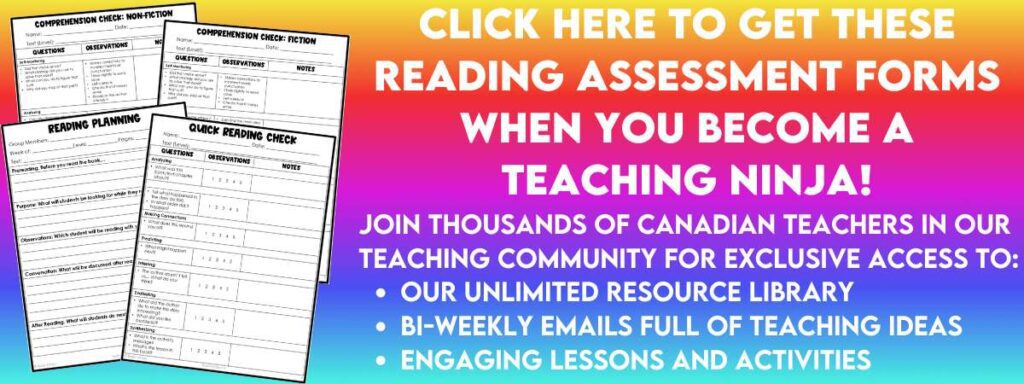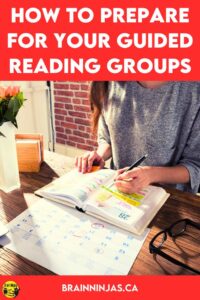
You’ve been asked to do teach reading as part of your Language Arts program and you’re a little worried. It seems overwhelming. Teaching reading can be challenging.
We’ve been there. It feels like you have to learn so much on the spot and you’re concerned that you won’t do a good job. Here’s the truth. You’ll learn as you go and you will get better at it. Everyone has to start somewhere.
A big part of doing a good job maximizing your teaching time with students comes from being prepared and organized. So, let’s dig in and get you organized so you can do a great job of teaching reading.
Prepare Your Students
Before you can even think about having students join you at the table, you’re going to need to have all the other students working on something. Instead of going into detail about that here, we think you should read this post: How to Teach Small Groups and Keep the Rest of the Class Busy It will give you some background on how to teach your students to build stamina for working independently.
When you are working with a group at the table you want your focus to be 100% on that group. Eliminating interruptions and distractions will help you make the most of your teaching at the table.
Choose the Reading Groups
The first big step in teaching reading is putting your students into groupings based on their level or reading ability. We’re not going to go into that too much in this post, but we recommend backing up and reading Help! I Don’t Know How to Teach Reading. It details how to find out the reading levels of your students so you can put them into groups and includes a quick assessment you can use to get started.
Choose the Texts
With any luck, your school has some sort of book room filled with levelled texts. Some of those book sets might even come with a lesson attached. If that’s the case, your planning will be even easier, but try to find a couple of books at the level for each of your groups (especially if it’s a shorter text).
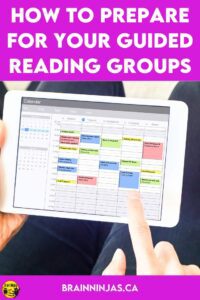
Ninja Note: Find a coworker who knows the school well enough to show you the ins and outs of the book room.
It will take a few weeks into your Guided Reading practice before you can nail it on the first try. Don’t worry if some of your students say they’ve read the book or if you choose the wrong type of book for what you need. They can practice a new skill when they read it with you.
Keep track of which book is for which group. This will help you in your planning and when you’re choosing new books for your groups again.
Plan the Lesson
Each time your students come to the table, that is a lesson. In between the lessons they may have reading tasks or small writing assignments to complete in order to prepare for, review or complete the lesson.
To help you out, we’ve got a Reading Groups Planning Page, as well as a set of reading assessment forms that can be used with any text in your classroom, ready for you to print and use. You can find this in the Resource Library if you’re already a ninja. Not a ninja? We’ll send them directly to your inbox when you sign up for our email list.
If your book package comes with a ready-made lesson, the time you will need will be reduced slightly because you won’t have to look through as much of the book to get ready, but generally, it is your job to figure out these things before students arrive at your reading table:
- what will students read?
- what skill will they practice?
- how will you assess this?
- what will they do next?
If you can answer the above questions, you’ll have a plan. Here’s how to create that plan:
- preview a chapter or the pages you’ll be reading. This is not reading the whole text. This is just previewing.
- Decide on the purpose for reading. What is the skill students will be practicing? How will you teach it? When you’re preparing your lesson you’ll write this on a board that students will be able to see and refer to.
- decide on how many pages students will read at the table. Hint-it always takes them longer than you think it will. This will also be the time you assess a student, so it will need to be long enough for you to do this. We usually try to plan for 8-10 minutes of reading.
- think about some questions you can ask your students while they sit and discuss the book. This happens after you’ve assessed the student reader and the whole group is having the discussion. You can assess student answers during this time if you plan out questions in advance. Use the open ended questions from our Quick Assessment to help. You can find it in our Resource Library.
- decide what you want your students to do next. It could be a short writing task or they could read more of the book. If you send them to read, be sure to give them a purpose to give them a reason to read.
Once you’ve planned a lesson for one group, repeat the process until all of your groups have a lesson ready to go.
Sort Out Your Schedule for Teaching Reading
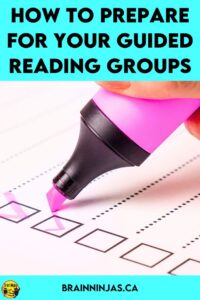
This can be challenging depending on how much autonomy you have over your schedule. In Alberta, where we teach, the minutes of instruction required for each subject area is a percentage of the total student minutes required by the government over each week. This means we generally get to decide how many minutes each day are dedicated to each subject.
We don’t teach in a bubble, so other teachers for subjects like music or French impact our schedule. Physical education usually happens in our school gymnasium and our book exchange happens in the library.
Once all of these scheduling times are given to us, we can schedule our Guided Reading. We try to meet with every group for at least thirty minutes a week. If we have a group working below grade level we try to schedule a second lesson with them. Most years we schedule this for about thirty to sixty minutes a day at some point in the morning, but we’ve had to put it in the afternoon when it didn’t fit anywhere else.
If it’s a sixty-minute lesson, we try to meet with two groups back to back. This setup has only worked with student groupings where they can work on a project like Literature Circles or something that takes a little longer independently. It won’t work for all classes. You can find our Twisted Lit Circles in our TpT Store ($USD) or our BN Shop ($CAN).
If you have a short week, it will throw your schedule out the window. If this happens, we recommend dropping the lesson for your highest levelled group. Instead, have a quick meeting with them so you can give them their next reading. You can catch up in your next lesson with them by extending the lesson a little. These students tend to need less time in their lessons as they move through the lessons quickly.
Keep in mind that teaching reading is just one part of your Language Arts programming, so you don’t want to schedule all your minutes into reading groups.
We also plan our reading lessons in cycles that match our terms (semesters). Groups read a novel at least once a year, or two for groups that can handle longer readings. We plan book clubs for our groups as part of our reading activities.
Assemble your Materials for Teaching Reading
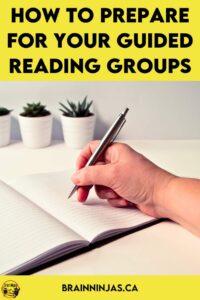
Keep a basket with things you might need for the lessons right beside the table where you’ll need them. Having these items nearby will save you time during your lessons and keep your students focused on their tasks (because you haven’t left the table to look for something). Here are some items we keep close by:
- student whiteboards
- whiteboard markers/erasers
- sticky notes: these are great for student notes, but we also use them to have students label the books they are using. This way we always know who left their book somewhere or what group it belongs to.
- pencils
- pens
- a visual timer: this will help keep you on track during the lesson
- highlighters
- assistive tools that you might use to help students with reading struggles such as highlighter reading strips or rulers
- scrap paper
- a purpose board: this will be a place you write the purpose for each lesson that you have so carefully put in your plan.
- a table where you can face students and they can sit facing like a U shape or a small circle: this helps encourage communication and makes talking to each other more natural. You will likely become an expert in reading and writing your students’ work upside down.
- chairs or seats for each student (they can bring them to the table if you don’t have enough chairs)
- a shelf, basket or bin to keep the materials for each reading group. This will help you stay organized. Keep the books and lesson materials for each group in their own bin so it’s quick to switch between groups.
- a binder to record student observations when they read to you one-on-one or if you can make observations during the discussions at the table.
- reading materials
Create a Planning Routine for Teaching Reading
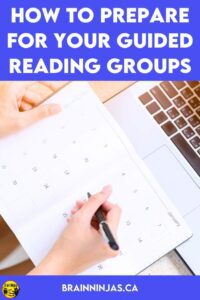
Building routines with your students is important because it saves time and energy in the day. The same is true when you’re thinking about your own planning routines. To stay on top of your planning, you will need to keep everything organized before it becomes a problem.
Choose a day and time that you can roughly outline a week of reading group lessons at once. Another way to plan is to plan one month of lessons for a group at a time. We usually plan from Wednesday to Wednesday. This means we never have to plan on a tired Friday afternoon or first thing Monday and we don’t have to use our weekends sorting our Guided Reading.
Try to make one trip every two weeks to the book room instead of going back and forth. Don’t forget to return the books you’ve finished with as often as you can. Nothing will annoy your coworkers more than you hoarding all the books. Put the books back in their packages as you go so you don’t have loose books everywhere. This will save you time because you won’t have to hunt down copies.
It really does get faster as you go. When you first start planning for your groups it will seem to take forever, but as you get through some of the lessons and better get to know and understand what your readers need, you will become more efficient and thus faster.
Assign a Book Master
In each of your reading groups, assign a book master. This person is in charge of collecting all the materials from the group to make sure they get returned. So, if you send your group away with a reading from a book, they would make sure that everyone returns their book to the group’s bin. This way, you only have to check in with your book masters instead of every single person in your class.
The book master can also be helpful in handing out materials or being the person in charge of letting the group members know about the day’s lesson or task. They can help out a student who might have been away and need to catch up.
Being organized and prepared will help you feel calm so you can focus on the point of Guided Reading, teaching students to read. You won’t have to waste precious teaching moments looking for teaching materials or being interrupted by those little darlings who want your attention.
Once you’re ready to start Guided Reading, you should read What the How to Teach Small Groups and Keep the Rest of the Class Busy and How to Run Your Reading Instruction.
Are you looking for other Language Arts ideas?
- Give Your Reading Instruction an Easy Twist
- How to Teach Reading With Book Clubs
- How to Use Google Meet to Run a Book Club
- Research Skills: How to Teach Text Features
- How to Celebrate Poem in Your Pocket Day
- Practical Strategies for Reluctant Readers
- Add Great Content to Your Literacy Lessons
- How to Set Up Your Reading Comprehension Schedule
- Challenge Your Students with Writing Activities Every Day
- 22 Amazing Ways to Use Word Wall Words
- How to Include Different Types of Writing in Your Classroom
Is there anything else that you do to be prepared to meet with your reading groups? If we missed something, please comment below and we’ll add it to our list. If you still have questions, ask us those too. We want this to be as helpful as possible for you.

